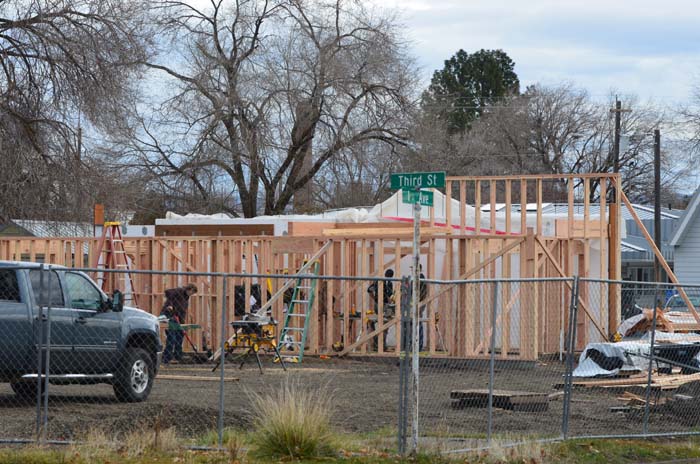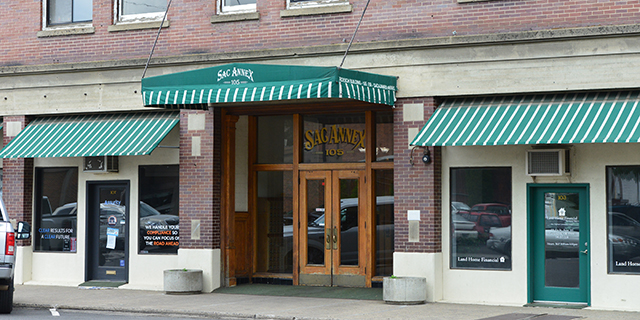Getting a jump on housing: Governor’s council wraps up busy year with recommendations
Published 8:00 am Sunday, March 17, 2024

- Construction continues on the La Grande High School District’s Tiger House Project on Dec. 5, 2023. A new poll commissioned by the Oregon Realtors shows that Oregon voters view housing costs and availability as the top issue facing the state.
PENDLETON — The word was out: Gov. Tina Kotek wanted to form an advisory committee to brainstorm ways to ramp up housing construction across the state.
The need for more housing is apparent throughout Oregon, with estimates that the state needs to build 36,000 new units each year over the next decade to dig out of a hole that has been years in the making. This was a committee that would need to do a lot of work — and would have only about a year to do it.
Nevertheless, when a state official called J.D. Tovey, at the time the planning director for the Confederated Tribes of the Umatilla Indian Reservation, to make the pitch that somebody from the tribes — maybe even Tovey himself — would be a good fit on the committee, he didn’t need much persuading.
“I just threw my hat in the ring full-blooded,” Tovey said, adding that he received permission from the tribes’ board of trustees and applied for what became known as the Housing Production Advisory Council. Not only did Tovey win that seat on the council, he became its co-chair.
Tovey, who now works as the CTUIR’s deputy executive director, knew all about the housing challenges facing the state and had worked on housing issues on the reservation and elsewhere.
Even though the problems facing the tribes were unique in some ways, Tovey started to see connections: “We also recognized that our problem isn’t just ours; it’s everybody’s problem,” he said. “We just realized that these are all interconnected and interrelated to each other. And so that was part of my interest in having that experience (with the Housing Production Advisory Council) and going through that process.”
The council recently released its final report, including 59 recommendations. Some of the recommendations are sweeping — reform Oregon’s tax system to help fund housing production, for example. But the report also includes other, seemingly smaller recommendations that could help speed housing production, such as creating electronic filing options for cases before the state’s Land Use Board of Appeals.
Some of the recommendations were included in Kotek’s package of housing bills in the recently concluded legislative session — but many of the remaining items, she said, will take longer to put into place and will involve tough conversations.
“We wanted to get through this session, see where we are, look at the rest of the recommendations and keep going,” Kotek said in a recent interview with EO Media Group journalists. The work that lawmakers did during the short session is by no means the end of the story, she said.
“So, a warning to the Legislature, we’re going to keep talking about housing, because there are different tools, things that are going to take a little longer,” she said.
On the councilThe council included 18 members appointed by the governor, along with seven other members representing the Legislature and state agencies. Tovey served as co-chair, along with Damien Hall, a Portland attorney with land use and real estate experience.
Tovey gives credit to Kotek for giving the council free rein.
“There wasn’t a litmus test for what’s on the table, or what’s allowable to be discussed or not; we never had that direction,” he said. Instead, the governor’s instructions to the council were to “turn over every rock and really poke a stick into things to see what’s actually causing these challenges.”
And the council had less than a year to do that poking and to work up its recommendations.
“I would say, honestly, it was frenetic,” Tovey said. “Our wheels were turning before we even hit the ground.”
It helped that the council wasn’t exactly starting from zero.
Tovey said many of the recommendations the council started working on had been bubbling up from agencies and departments in state government for years, “and so we had a large initial list of things to at least look at.”
The council also solicited public input and then broke into five work groups, each one taking a look at a critical overarching issue. One work group, for example, looked at availability of land. Another group looked at code and design issues. The other groups examined the application processes for land development permits, financing and workforce shortages.
“I have to give the credit to the work group chairs,” Tovey said. “They were the ones that did most of the cat herding. … I think the work group leaders are the heroes in this entire process.”
By one point, though, council members had compiled about 200 recommendations, so the group had to winnow those down to the 59 that made its final report. Tovey said the group used three major criteria to assess recommendations:
• Impact potential: What is the number of housing units that would result from the recommendation?
• Equity and racial justice: Will the recommendation improve housing outcomes for communities of color or other marginalized groups?
• Feasibility: How feasible is the recommendation?
‘Compounding effects’
Of the recommendations that survived the winnowing, Tovey said he believes the ones that will have the most impact for Eastern Oregon involve making sure that local governments have the necessary resources to permit a housing boom and figuring out ways to pay for infrastructure.
Small local governments such as the ones across Eastern Oregon may not have the capacity to handle the increased regulatory workload that will come with additional construction — and that includes not just permitting, but revising local land-use regulations as necessary.
Similarly, building 36,000 new housing units every year will put pressure on those governments to find ways to pay for infrastructure — making sure those new houses are connected to water, sewer and streets.
The package of housing bills passed by the short session of the Legislature earlier this month included some of the council’s recommendations.
Lawmakers approved more than $100 million for cities to use for infrastructure needs and $75 million for a revolving loan fund cities could use to spur developers to build less expensive homes. The package also includes a one-time opportunity for cities to expand their urban growth boundaries — the state-approved lines that dictate where and how cities can grow — without jumping through all the hoops such expansion usually requires.
But other recommendations will take more time to work through than is available in a legislative short session. And Tovey said Kotek warned council members that they were playing a long game.
“The governor did say that a lot of the harder conversations might be coming up next year,” in the 2025 legislative session, Tovey said. “And so she asked us to be on standby for any kind of future work with that.”
And, while he understands that some of the bigger recommendations will take time or might fall by the wayside, he also knows that even the items that seem a little smaller could make a big difference in the long run.
“Some of these are — I don’t want to say they’re simple fixes, but they’re very small, little pieces that might have compounding effects in the housing production pipeline,” he said. “Also, if we do one thing, what’s the impact of that one thing in relation to the rest of the ecosystem of housing production? So I think it’s going to be interesting to see how these flow out.”
Council recommendations
Here are some of the 59 recommendations from the Housing Production Advisory Council, as crafted by the council’s five work groups:
Availability of Land
• Leverage state-owned and leased land for housing production. Focus on land inside urban growth boundaries that already has needed services and infrastructure; requires no legislative action.
• Provide resources to help cities overcome infrastructure barriers to housing. Some of this was addressed during the short session of the Legislature this year.
Land Development Permit Applications
• Modify rules governing so-called “cottage clusters” and middle housing. Middle housing typically is defined as multifamily or clustered housing types compatible in scale with single-family or transitional neighborhoods.
• Establish electronic filing for cases before the Land Use Board of Appeals.
Codes and Design
• Modify tree codes in housing development situations in order to make the greatest use of land available in urban settings.
• Allow use of a single staircase for buildings up to five floors.
Finance
• Create a state of Oregon fund that finances critical local infrastructure. The short session of the Legislature did allocate more than $100 million for infrastructure needs.
• Generate new state-level revenue to fund local infrastructure.
Workforce Shortages
• Modify ratio standards in trade apprenticeship programs.
• Create a five-year construction workforce development program to connect workers with jobs.









